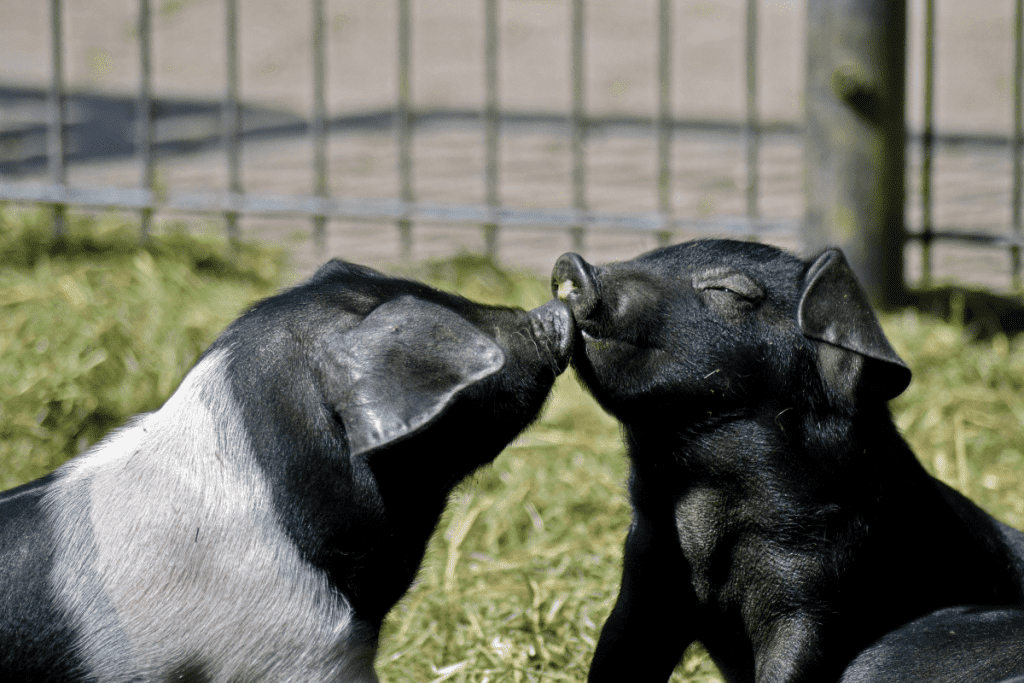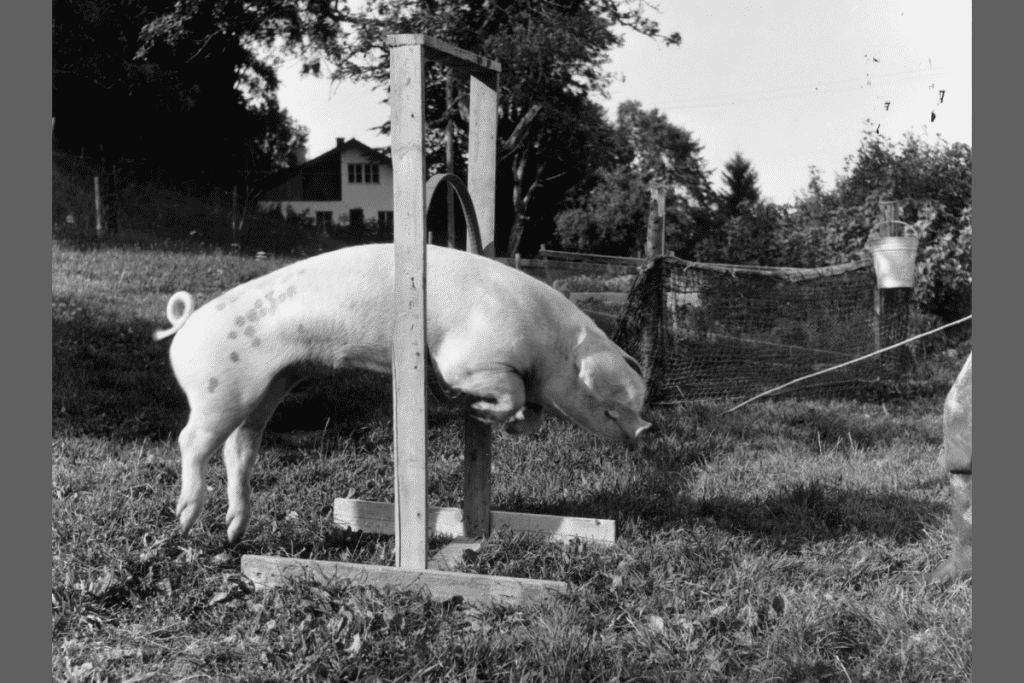Pigs are perhaps some of the most overlooked animals–they’re incredibly useful, surprisingly intelligent, and are one of the most commonly kept types of livestock on the planet.
It turns out these even-toed, omnivorous ungulates are fascinating animals!
As you’ve guessed by now, we’ll mainly be covering whether or not pigs can look up in this article, but we’ll also go over lots of other interesting facts you probably didn’t know about them.
Due to their unique bone structure, pigs cannot lift their heads to look straight up above themselves. Their necks are too short and have a very limited range of motion since pigs have evolved to stay low to the ground.
Read on to learn all about pigs and whether or not this common assumption about them is fact or fiction.
In addition, we’ll talk briefly about lots of other questions you probably have had about pigs at some point!

Table of Contents
ToggleCan Pigs Look Up?
While pigs are certainly able to physically angle their eyeballs up toward the sky, the overall lack of mobility of their neck muscles and the structure of their spines means they aren’t able to lift their heads straight upward.
Interestingly, whether or not pigs can look up sort of depends on how you define “looking up.”
As far as lifting their heads directly up toward the sky while standing, pigs are unfortunately very limited in this regard.
While many animals, including us humans, simply lift our chins upward to look above ourselves, the typical pig’s anatomy doesn’t allow for this range of movement.
However, pigs can see themselves above themselves by sitting or lying on their backs.
Their necks just lack the mobility to angle directly upward.
They have a tiny amount of room to lift their heads slightly, but nowhere near as much as animals like us or even other livestock like goats, horses, and chickens.
One of the main reasons pigs cannot look up in this way is because they’ve evolved to prioritize accessing food.
As many farmers are fully aware, Pigs are extreme omnivores and skilled foragers, so they’re usually looking down at the ground in search of food.
Pigs will even eat their own poop! (Learn more about this habit in our article.)
More specifically, they search for food by rooting or digging in the dirt with their tough yet sensitive snouts.
In short, pigs don’t climb, fly, or otherwise have much biological reason to have a full view of the sky, so their bodies have evolved to have a very limited range of motion in their necks.
Their vision is also fairly poor, and they rely more on their hearing and sense of smell to survive.
This means they can’t look behind themselves, either, unless they fully rotate their bodies.
Despite these physical restrictions, these remarkable animals are highly intelligent and have evolved perfectly for what they need to do to get by.
Do Pigs Have Two Necks?
Technically, pigs have just one neck, with a single trachea, esophagus, tongue, etc. Still, in the context of food production like cappocolo (which is derived from pigs’ necks), it’s often divided into two lateral sections: the left and right.
Of course, this doesn’t mean pigs have an extra neck jutting out of the side of their head or anything.
It’s just a common way butchers divide the neck into two sections to get cappocolo from each side or each “neck.”
In reality, pigs have a single neck, with one mouth, one head, and one of, well, every other part which makes up the neck.
However, there are some interesting things to note about pigs’ necks.
For one, their necks are much, much shorter than those of most other livestock and even other related ungulates.
This is why, as we touched on earlier, pigs aren’t able to look up in the same way most other animals do, i.e., by pivoting their chin directly upward.
But the typical pig’s neck still has the typical seven cervical vertebrae in the spinal column; these vertebrae are just packed a lot more tightly together than we would see on, for example, a deer or a cow. Pigs’ necks are also very thick and muscular.
They have a lot of connective tissue, making the muscles quite tough and rigid.
The reason pigs’ neck muscles are so strong is likely because of how they’ve evolved.
Rooting around in the ground for food so often requires a sturdy neck, after all, and most animals evolve in a way to optimize their access to food.
Can Pigs Jump?

Despite not looking up, domestic pigs can jump, just not very high or very far. While their wild hog relatives are agile and able to jump as high as 3’ feet, domestic pigs can barely jump more than a few inches off the ground due to their more limited bone structure.
Once again, pigs’ bodies simply haven’t evolved to prioritize jumping.
Since they stay so low to the ground when searching for food, they don’t have much of a reason to need to jump or leap high in the air or over long distances.
They can hop an inch or two off the ground on occasion, but you won’t have to worry about any pigs on your hobby farm scaling your 4’-foot-tall fencing any time soon.
Piglets are a bit more agile than adult pigs, as they are lighter, a little more flexible overall, and smaller.
Still, even they are very limited in their ability to lift themselves to jump or leap over anything.
On the other hand, pigs are very skilled at digging!
You’re a lot more likely to encounter your pigs escaping by digging holes under your fences or other structures than them climbing or jumping over anything.
Pigs’ bodies are short, stocky, and muscular, including their legs and hooved feet.
The weight of their legs makes them unable to lift themselves off the ground very far, but their body structure is perfect for digging, swimming, and even sprinting short distances at surprisingly high speeds.
But apparently, the phrase “when pigs fly” has some truth to it, as you’re never going to see a pig making huge leaps and bounds like, for example, a taller and more lightweight ungulate like a goat or a deer.
Can Pigs Swim?
Pigs are excellent swimmers, once again in part thanks to their highly unique bone structure and muscular yet buoyant lower bodies. They even enjoy swimming and will gladly take to water if they have access to it!
If you have pigs of your own, it’s a good idea to supply them with a small pond or at least a kiddy pool for them to splash around in.
Not only will this help keep them cool in the hot summer months, but it’ll also keep them greatly entertained and active.
Just make sure the water isn’t too deep, as they aren’t nearly as skilled at swimming underwater.
Since pigs’ bodies are naturally buoyant and float on their own, all they need to do is wiggle their stubby legs to move forward.
Though these legs are short and stocky, they’re heavily muscled, meaning they’re well-equipped for both running and swimming–just not jumping.
Pigs’ wilder relatives like boars and wild hogs are even more agile swimmers!
Do Pigs Cry?
Pigs technically do cry, but not quite in the way, humans do when they’re distressed. They only produce tears to keep their eyes moistened, not so much in response to emotional stimuli. Pigs will, however, squeal if threatened, upset, or hurt.
Most animals can produce some kind of cry, yell, squeal, hiss, or other defensive sounds when they are in pain or afraid, including pigs.
However, they don’t cry as humans do, i.e., weeping and crying tears from their eyes.
Currently, most scientists believe only humans can cry in this manner.
This doesn’t mean pigs don’t feel emotions, though!
They are one of the most intelligent, sensitive, and curious animals in the world.
They are even more intelligent on average than dogs, and they are very social, playful, and able to play simple games and even complete basic memory puzzles with impressive accuracy.
It’s estimated pigs have about the same level of cognitive intelligence as human toddlers.
Do Pigs Bite?
Pigs have sharp incisors and canine teeth and can bite with a surprising amount of force. They have 44 teeth in total, most designed to break up plant matter. Pigs aren’t particularly aggressive, but they will occasionally bite and charge at people if they feel threatened.
In general, you don’t have to worry about the typical domestic pig suddenly lunging at you and chomping your hand off.
Still, they sometimes show aggression (mainly towards each other) in certain situations.
Pigs establish social hierarchies amongst one another via aggressive and submissive behaviors, and sometimes more aggressive pigs will bite each other to reaffirm their place within said hierarchies.
Additionally, male pigs get more aggressive towards one another when competing for food, mates, or territory.
It’s best to avoid getting between any pigs engaging in this kind of behavior, as it is a normal part of their social interactions with one another.
Some pigs will also show mild aggression towards strangers until they get to know others and feel more comfortable around them.
Most domestic pigs are typically pretty docile, though, and they don’t seek out humans to bite or charge at unless they are threatened, stressed, or hungry.
If you have pigs of your own, simply keeping them well-fed with a variety of healthy foods and offering them plenty of space to roam for enrichment is enough to keep aggression to a minimum.
How useful was this post?
Click on a star to rate it!
We are sorry that this post was not useful for you!
Let us improve this post!
Tell us how we can improve this post?
